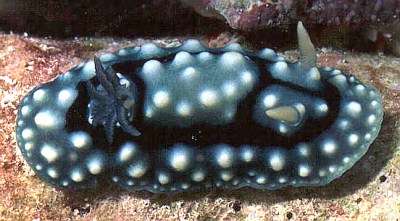
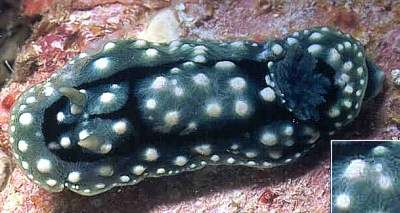
Aldisa williamsi
Elwood, Valdes & Gosliner, 2000
Order: NUDIBRANCHIA
Suborder: DORIDINA
Superfamily: EUDORIDOIDEA
Family: Dorididae
DISTRIBUTION
Known only from Madang, Papua New Guinea, and Sulawesi, Indonesia.
PHOTO
Tukang Besi Archipelago, SE Sulawesi, Indonesia. Upper: Size: 23 mm, 2 July 1999, Pulau Hoga. Lower: 26 mm long, 12 July 1999, 16m on Pulau Tolandono. PHOTOS: Lindsay Warren.
Similar to Discodoris liturata but differs in background colour and colour of gills and rhinophores. See the phyllidiid mimic page for references to other similar species.
Note: This species was previously known on the Forum as Doris? sp. 10.
Reference:
• Elwood, H.R., Valdes, A. & Gosliner, T.M. (2000). Two new species of Aldisa Bergh, 1878 (Mollusca, Nudibranchia) from the tropical Indo-Pacific. Proc. Calif. Acad. Sci., 52(14): 171-181.
Rudman, W.B., 2002 (March 11) Aldisa williamsi Elwood, Valdes & Gosliner, 2000. [In] Sea Slug Forum. Australian Museum, Sydney. Available from http://www.seaslugforum.net/find/aldiwill
Related messages
Aldisa williamsi from Indonesia
September 8, 2003
From: Roberto Sozzani
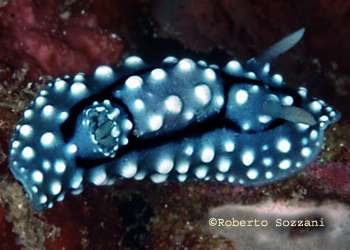
Dear Bill,
I'm back from a long trip to Indonesia and now working on thousand of photos and many many doubts, as usual...
Here is one of them: when I shot the photo, I thought it was a Chromodoris geometrica. But colors are different. Now, reading an August message, I've seen a similar photo, identified as Aldisa williamsi. Is this the same?
Location: Pandar Is. - Indonesia
Depth: 12 mt.
size: 15 mm.
Thanks for your help
Best regards
roberto.sozzani@fastwebnet.it
Sozzani, R., 2003 (Sep 8) Aldisa williamsi from Indonesia. [Message in] Sea Slug Forum. Australian Museum, Sydney. Available from http://www.seaslugforum.net/find/10912Dear Roberto,
Yes this is Aldisa williamsi
Best wishes,
Bill Rudman
Aldisa williamsi from Indonesia
August 23, 2003
From: Linda Ianniello
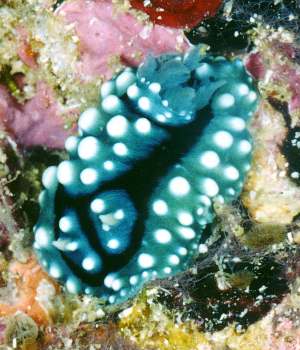
Dr. Bill,
The Phyllidias are tough enough to identify, but here is one I am really stuck on. It looks like a Phyllidia with gills .... some kind of dorid? Sorry, I don't seem to have the rhinophores; I didn't notice the gills at the time I was taking the picture so didn't realize it was unusual until the film was processed. The only similar slug I could find is on page 110 of Ono Atsushi's book Opisthobranchs of Kerama Islands. Since I can't read Japanese, all I can determine is that he calls it a "Doris sp 1".
Date: August, 2003
Dive Site: Yellow Wall of Texas at Rinca Island, Indonesia
Depth: 55 feet
Regards,
Linda I.
lindai@us.ibm.com
Ianniello, L., 2003 (Aug 23) Aldisa williamsi from Indonesia. [Message in] Sea Slug Forum. Australian Museum, Sydney. Available from http://www.seaslugforum.net/find/10812Dear Linda,
It is amazing what we can find in photos. This is one of the amazing 'phyllidiid mimics'. It is Aldisa williamsi. Another similar one is Aldisa erwinkoehleri, but it doesn't have the black rings around the gills and rhinophores as in A. williamsi
Best wishes,
Bill Rudman
Aldisa williamsi from Indonesia
October 1, 2002
From: Olivia
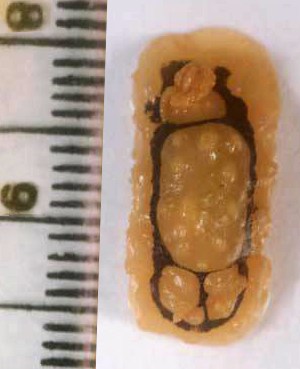
Dear Bill,
Could you help us to identify this animal. The original colour was light green - yellow with the rhinophore and gills a simila colour.
Dive site: 17 islands, Riung near Flores island
Date: October, 2001
Depth: 3 - 7 metres
orriginal collour: light green - yellow
Thanks,
Olivia,
Indonesia
olivia_inigue@yahoo.com
Olivia, 2002 (Oct 1) Aldisa williamsi from Indonesia. [Message in] Sea Slug Forum. Australian Museum, Sydney. Available from http://www.seaslugforum.net/find/8082Dear Olivia,
It is always difficult to be sure with preserved animals, but from the tubercles on the back and the black markings, I am pretty sure this is Aldisa williamsi, one of a number of dorid species which apparently mimic species of the Phyllidiidae.
Best wishes,
Bill Rudman
Aldisa williamsi - a phyllidiid mimic
March 13, 2002
From: David W. Behrens
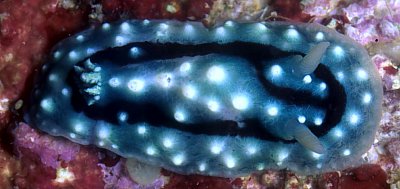
Bill:
The animal on the Forum known as Doris sp. 10 is now named. It is Aldisa williamsi Elwood, Valdes and Gosliner, 2000, named in recognition of Dr. Gary Williams of the California Academy of Sciences in San Francisco. The attached photo by Terry Gosliner is of a paratype from Barracuda Point, Papua New Guinea [CASIZ 109791].
Reference:
Elwood, H.R., Valdes, A. & Gosliner, T.M. (2000). Two new species of Aldisa Bergh, 1878 (Mollusca, Nudibranchia) from the tropical Indo-Pacific. Proc. Calif. Acad. Sci., 52(14): 171-181.
Dave Behrens
dave@seachallengers.com
Behrens, D. W., 2002 (Mar 13) Aldisa williamsi - a phyllidiid mimic. [Message in] Sea Slug Forum. Australian Museum, Sydney. Available from http://www.seaslugforum.net/find/6401Thanks Dave,
I have been meaning to update Doris sp. 10 and Doris sp. 2 which has recently been named Aldisa erwinkoehleri.
Cheers,
Bill Rudman
Another phyllidiid mimic from SE Sulawesi
February 22, 2000
From: Lindsay Warren


Dear Bill
You may remember my sending you a shot of a pink, black and white dorid which seemed to be imitating a Phyllidia and you identified as Discodoris? liturata. Last season I found another imitator but this time a turquoise blue, black and white one (UPPER PHOTO) at 4.30 pm on 2 July 1999 at a depth of 5 m on a dead coral boulder with low growing green algae flanked by a pale green sponge massive. Size: 23 mm. Pulau Hoga, Tukang Besi Archipelago, SE Sulawesi, Indonesia. [Operation Wallacea].
It moved very slowly and the mantle had the same tough granular feel of a Phyllidia. The overall colour is dark turquoise with a black band running submarginally around the mantle, a line between and behind the rhinophores and around the branchial plume. Over the mantle are simple, white capped pustules - larger on the notum and smaller ones around the mantle margin. The foot is the same colour as the body. The pale cream rhinophores dusted with dark turquoise are retractile lamellate with pustules on the rhinophore sheaths. In this first specimen, the dark turquoise branchial plume featured 8 simple, single plumes.
However a second specimen (LOWER PHOTO - size: 26 mm) found by Iain McKeith on 12 July at 16.10 pm at a depth of 16m on Pulau Tolandono had more complex branched plumes. The only other difference in external appearance with this second specimen was that
there were white 'streaks' coming off the centre of the larger pustules. Photos: Lindsay Warren.
Have you seen this one before?
All the best
Lindsay Warren
100014.2112@compuserve.com
Warren, L., 2000 (Feb 22) Another phyllidiid mimic from SE Sulawesi. [Message in] Sea Slug Forum. Australian Museum, Sydney. Available from http://www.seaslugforum.net/find/1937Dear Lindsay,
Although similar to your Discodoris? liturata this species certainly has some differences in colour. Have a look at the phyllidiid mimicry page for a list of other phyllidiid mimics we now have in the Forum.
The white streaks you mention (photo inset) are dermal spicules found to varying degrees in quite a lot of the dorid nudibranchs.
Thanks for another interesting animal,
Bill Rudman.
